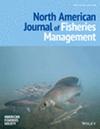变暖水域中的冷血:气候变化中气温、降水和地下水对海湾鲟鱼热栖息地的影响
IF 1.4
4区 农林科学
Q3 FISHERIES
引用次数: 0
摘要
目标在不断变化的气候中,气温、降水和地下水对水温和海湾鲟(Acipenser desotoi)热栖息地适宜性的影响尚不十分清楚,海湾鲟已被美国濒危物种法案列为濒危物种。因此,我们将这些因素纳入热栖息地模型,以预测 2024-2074 年广泛的气候变化情景可能对海湾鲟造成的影响。方法利用佛罗里达州 Choctawhatchee 河的数据,我们开发了降水和地下水校正气温-水温模型,将其准确性与渔业管理中使用的传统气温-水温模型进行了比较,并预测了未来海湾鲟正常生理功能和野外工作(即:种群取样和遥测手术)的热栖息地适宜性、结果降水和地下水校正模型比传统空气-水温模型更准确(调整后 R2 的平均改进 = +0.45;范围 = +0.09 至 +0.75)。在包括不同气温、降水和地下水系统的气候变化情景下,预计水温升高的速度差异很大。重要的是,与非聚集区相比,海湾鲟夏季聚集区温度较低,受降水和地下水影响较大,受气温影响较小。如果作为降温驱动因素的降水和地下水在不断变化的气候中变暖,预计夏季聚集区的热栖息地退化程度将等同于或大于非聚集区。结论我们的研究结果为聚集区在夏季为海湾鲟提供凉爽的水和能量储蓄这一前提提供了水文背景,强调了通过地下水保护、水质监测和河岸/流域栖息地管理来保护这些栖息地的重要性。我们的研究结果表明,随着气候变化的加剧,确定野外工作活动的温度适宜时间将变得越来越重要,时间限制也越来越多。不过,我们的研究为管理者提供了一系列水温模型,以及一种准确、经济、与管理相关的方法,用于预测海湾鲟和其他物种在不断变化的气候中的热栖息地条件。本文章由计算机程序翻译,如有差异,请以英文原文为准。
Cold blood in warming waters: Effects of air temperature, precipitation, and groundwater on Gulf Sturgeon thermal habitats in a changing climate
ObjectiveIn a changing climate, the effects of air temperature, precipitation, and groundwater on water temperature and thermal habitat suitability for Gulf Sturgeon Acipenser desotoi , listed as threatened under the U.S. Endangered Species Act, are not well understood. Hence, we incorporated these factors into thermal habitat models to forecast how Gulf Sturgeon may be affected by wide‐ranging climate change scenarios in 2024–2074.MethodsUsing data from the Choctawhatchee River, Florida, we developed precipitation‐ and groundwater‐corrected air–water temperature models, compared their accuracy with that of conventional air–water temperature models used in fisheries management, and projected future Gulf Sturgeon thermal habitat suitability for normal physiological functioning and fieldwork (i.e., population sampling and telemetry surgeries) in summer (May–August) under 16 climate change scenarios.ResultPrecipitation‐ and groundwater‐corrected models were more accurate than conventional air–water temperature models (mean improvement in adjusted R 2 = +0.45; range = +0.09 to +0.75). Water temperature was projected to warm at widely variable rates across climate change scenarios encompassing different air temperature, precipitation, and groundwater regimes. Importantly, Gulf Sturgeon summer aggregation areas were cooler and influenced more by precipitation and groundwater and less by air temperature than were non‐aggregation areas. If precipitation and groundwater—as drivers of cooling—become warm in a changing climate, summer aggregation areas were projected to exhibit thermal habitat degradation equivalent to or greater than that of non‐aggregation areas.ConclusionOur results add hydrological context to the premise that aggregation areas provide cool water and energetic savings for Gulf Sturgeon during summer, underscoring the importance of protecting these habitats through groundwater conservation, water quality monitoring, and riparian/watershed habitat management. Our findings indicate that identifying thermally appropriate times for fieldwork activities will be increasingly important and time‐restricted as climate change intensifies. However, our research provides managers with a portfolio of water temperature models and an accurate, cost‐effective, management‐relevant approach to forecasting thermal habitat conditions for Gulf Sturgeon and other species in a changing climate.
求助全文
通过发布文献求助,成功后即可免费获取论文全文。
去求助
来源期刊
CiteScore
2.60
自引率
18.20%
发文量
118
审稿时长
2 months
期刊介绍:
The North American Journal of Fisheries Management promotes communication among fishery managers with an emphasis on North America, and addresses the maintenance, enhancement, and allocation of fisheries resources. It chronicles the development of practical monitoring and management programs for finfish and exploitable shellfish in marine and freshwater environments.
Contributions relate to the management of fish populations, habitats, and users to protect and enhance fish and fishery resources for societal benefits. Case histories of successes, failures, and effects of fisheries programs help convey practical management experience to others.

 求助内容:
求助内容: 应助结果提醒方式:
应助结果提醒方式:


